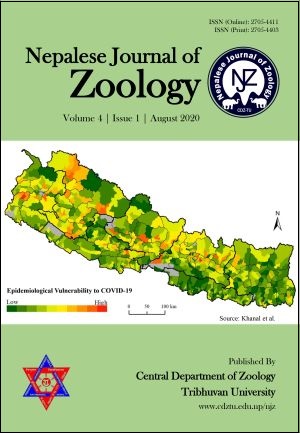Community vulnerability to epidemics in Nepal: A high-resolution spatial assessment amidst COVID-19 pandemic
DOI:
https://doi.org/10.3126/njz.v4i1.30670Keywords:
COVID-19, Epidemics, Municipal units, Nepal, Vulnerability mappingAbstract
The coronavirus disease 2019 (COVID-19), the biggest health problem at present, doesn’t have uniform transmission and severity among the countries and communities therein. Knowledge of community vulnerability to the disease would facilitate interventions aimed at transmission control by efficient deployment of available limited resources. Therefore, we assessed spatial variations and heterogeneity of disease vulnerability among the population in 753 municipal units of Nepal. We collected geospatial indicators representing the domain of socioeconomic inequalities, population dynamics, heterogeneity in accessibility and the information related to underlying health condition which potentially affect the severity of COVID-19 transmission. Those indicators were scaled to a common measurement scale and spatially overlaid via equally weighted arithmetic mean and then assembled to create three vulnerability indices using Geographic Information System; Social Vulnerability Index (SVI), Epidemiological Vulnerability Index (EVI) and a composite of the two- Social and Epidemiological Vulnerability Index (SEVI). The indices were classified into five level of vulnerability and the municipal units and the population within vulnerability classes were quantified and visualized in the map. The index output indicated high vulnerability to epidemics in metropolitan cities like Kathmandu, Pokhara, Bharatpur, etc.; developing cities especially in the Province No 2; and, municipal units of Karnali and Sudoorpashchim provinces. Additionally, some other municipalities such as Dhulikhel, Beshishahar, Tansen etc. which have a higher prevalence of pulmonary and cardiovascular disorders are highly vulnerable. The SVI indicated that 174 municipal units and 41.5% population is highly vulnerable. The EVI identified 55 municipal units and 40.7% of the total population of the country highly vulnerable to COVID-19. The SEVI accounted that disease vulnerability is high in 105 municipal units and 40% population of Nepal. The vulnerability indices created are means for different tiers of the existing government in federal system of Nepal for prioritization and improved planning for disease intervention especially in highly vulnerable municipal units where the COVID-19 transmission could have high severity.
Downloads
Downloads
Published
How to Cite
Issue
Section
License
This license enables reusers to distribute, remix, adapt, and build upon the material in any medium or format for noncommercial purposes only, and only so long as attribution is given to the creator.

